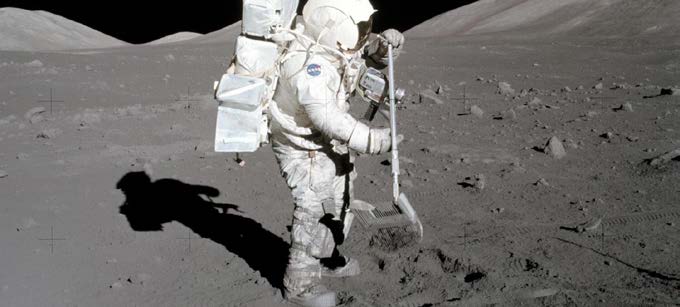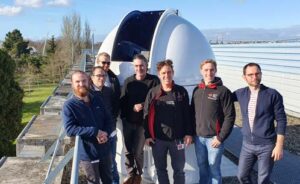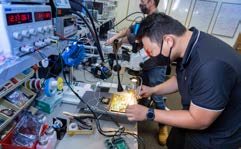Quantum-encrypted satellite communications, super-fast WiFi and NASA’s upcoming Moon missions could all benefit from technology developed by ICRAR’s Astrophotonics Group.

Apollo 17 astronaut and geologist Harrison “Jack” Schmitt on the surface of the Moon in 1972. (Credit: NASA)
When NASA’s Artemis missions touch down on the Moon, they will carry the first woman and the first person of colour to land on the lunar surface.
And ICRAR’s Astrophotonics Group want their technology to bring high-resolution footage of the astronauts to Earth.
The team are at the forefront of research into optical communications, an emerging technology expected to revolutionise data transfer from space.
“Most current space communications rely on radio waves—it’s the same technology that brought us the grainy footage of Neil Armstrong when the Apollo 11 mission landed on the Moon in 1969,” says Dr Sascha Schediwy, who leads the Astrophotonics Group.
“Free-space laser communications has several advantages over radio, including significantly faster data rates and hack-proof data transfer.”
“It’s the next-generation of space communications, and it’s likely to be how we’ll see high-definition footage of the first woman to walk on the Moon.”
Lessons From The World’s Largest Radio Telescope
The Astrophotonics Group is helping to enhance optical communications through the development of ‘phase stabilisation’ technology.

Members of ICRAR’s Astrophotonics group visiting CNES colleagues in Toulouse, France.
It allows laser signals to be sent from one point to another without interference from the atmosphere.
ICRAR physicist Dr David Gozzard says the technology builds on the team’s experience developing a phase synchronisation system for the Square Kilometre Array (SKA), the world’s largest radio telescope.
The group have been selected to manufacture the telescope’s synchronisation system at the University of Western Australia.
“The SKA technology we developed was for stabilisation of laser links through fibre optic cable,” Dr Gozzard says.
“But we need to do the same thing through the atmosphere, because the atmosphere contains turbulent pockets of hotter and colder air.”
These pockets of turbulence have a different refractive index, meaning light takes different amounts of time to propagate through it.
It messes with the precise timing signals required for laser communications.
“So this stabilisation technology we developed for the SKA, we’re now translating that to go to do the same thing for the atmosphere,” Dr Gozzard says.
The stabilisation technology could be adapted for other radio telescopes in the future, such as the next generation Very Large Array (ngVLA) in the United States.
Industry Links
Dr Schediwy said the group’s technology could help increase the data rate from satellites to ground by orders of magnitude.
“The next generation of big data-gathering satellites would be able to get critical information to the ground faster,” he says.
In 2021, the Astrophotonics Group set a world record for the most stable transmission of a laser signal through the atmosphere, together with researchers from the French National Centre for Space Studies (CNES) and the French metrology lab Systèmes de Référence Temps-Espace (SYRTE) at Paris Observatory.

Part of a circuit board for the synchronisation system that will be used for South Africa’s SKA telescope, SKA-Mid.
Dr Gozzard says laser links can also be used for experiments in fundamental physics, including testing Einstein’s theory of general relativity and searching for dark matter.
And the technology’s precise measurements have other practical uses in earth science and geophysics.
It could also contribute to the development of the ‘quantum internet’—secure global data transmission using quantum-key distribution via optical links to quantum satellites.
The Astrophotonics Group has funding from SmartSat CRC to develop optical communications technology, together with industry partners satellite manufacturer Thales Alenia Space satellite communications specialist Goonhilly Earth Station.

Kevin Choung working in the Astrophotonics lab at ICRAR/UWA.
And the team is collaborating with Fugro to use SpAARC, a world-class facility for remote and autonomous operations in space and other harsh environments, including mine sites.
Mission To The Moon
In 2020, the Astrophotonics Group partnered with the ARC Centre of Excellence for Engineered Quantum Systems (EQUS) and Goonhilly Earth Station to build the first optical communications ground station in the Southern Hemisphere.
The advanced communications ground station, installed at The University of Western Australia, will be capable of receiving data from spacecraft anywhere between low-Earth orbit and the surface of the Moon.
Dr Gozzard says there are more satellites generating more data than ever before, and were fast running out of radio bandwidth to get that information to the ground.
“We’ve got Elon Musk wanting to lob tens of thousands of satellites into orbit,” he says.
“We’ve got weather monitoring satellites, earth monitoring satellites, bushfire and disaster response satellites, space probes, communication satellites, GPS, and everything else that’s up there.
“And not only are we getting more satellites, they’re getting more sophisticated—their cameras are getting higher resolution, their other sensors are getting higher quality.”
The optical communications station could also support several ground-breaking space projects, including the Artemis missions.
“That would be really exciting,” Dr Gozzard says.
“In the group we’re all fans of The Dish movie, so we want the second movie to be about us.”